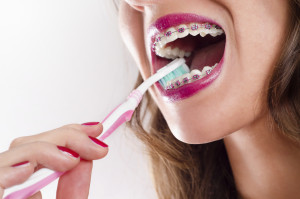 Patient: “I brush my tongue with my toothbrush when I brush my teeth.”
Patient: “I brush my tongue with my toothbrush when I brush my teeth.”
Dentist: “That’s fine, but you may only be packing the bacteria deeper into your tongue.”
Patient: “Oh?”
Dentist: “Yeah.”
That’s when your dentist may offer to show you how to use a tongue scraper (aka tongue cleaner) to remove a far larger amount of bacteria off the surface of your tongue. It may sound purely cosmetic, but in addition to reducing bad breath, scraping your tongue can reduce the prevalence of:
- Tooth decay
- Gum infections
- Food accumulation
That’s because your tongue is covered in little bumps called papillae that allow you to taste and feel. But bacteria harbors there, and can multiply quickly. Fortunately, most of those bacteria are the “good kind” that help you break down food. Other bacteria, not so much. They break down teeth and gums.
It’s also important to note that bad breath (halitosis) can occur for a variety of possible reasons. Tongue scraping is not a cure-all for chronic halitosis. Rather, it’s another surficial tool—like brushing and flossing—to help minimize bad breath.
The how, the when, the zen of scraping
Hopefully, you are already brushing your teeth at least twice a day and flossing once a day. Continue, or start, that please. Assuming you went to the local drug store and picked up a plastic or metal scraper—for about $10 or less—next, stick your tongue out and use light pressure to run the scraper across the entire surface of your tongue. Do this from back to front. Firm enough to scrape, not so hard it hurts.
Check the scraper for gunk and rinse it off with warm water after each scrape. Consider doing multiple passes until the gunk is next to nil or has no funky color. Finish by rinsing your mouth out with water thoroughly. If you’re at the dentist ask him or her about using zinc crystals on your tongue to help kill off even more of the bacteria.
Whatever gets scraped off your tongue won’t be a pretty color, but if there is or red discoloration, or if you get sores that persist for several days, please see your dentist.
Scraper caper
There shouldn’t be much mystery behind which scraper to get yourself and you shouldn’t have to break the bank either. Figure $10 or less will get you a perfectly adequate scraper. In fact, the most effective ones typically run cheaper. That’s because the $10-plus options are specially designed for kids or white tongue—the result of an overgrowth of the tongue’s papillae. The white coating is debris, bacteria and dead cells that are lodged between the enlarged and sometimes inflamed papillae.
Types of scrapers include:
- Metal—Easier to keep cleaner, longer
- Plastic—Economical and softer on the tongue
- With brush—Includes extra fibers to help with bad breath
- Disposable—Cheap in bulk
- Kid designs—Less intimidating to children than an ugly metal tool







Leave a Reply